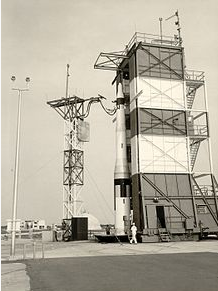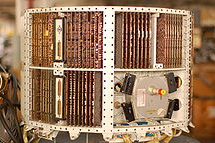
LGM-30 Minuteman
USINFO | 2013-10-09 13:56
The LGM-30 Minuteman is a U.S. missile, a land-based intercontinental ballistic missile (ICBM), designed to deliver nuclear warheads. As of 2010, the version LGM-30G Minuteman III is the only land-based ICBM in service in the United States. It is one component of the US nuclear triad, its delivery systems for strategic nuclear weapons, which is complemented by the Trident submarine-launched ballistic missile (SLBM) and by nuclear weapons carried by long-range strategic bombers. It was the first Multiple Independently Targetable Reentry Vehicle (MIRV) missile. Each missile carries three nuclear warheads, which have a yield in the range of 300 to 500 kilotons.
The letter “L” in “LGM” indicates that the missile is silo-launched; the “G” indicates that it is designed to attack ground targets; the “M” indicates that it is a guided missile.[1]
The name “Minuteman” comes from the Revolutionary War’s Minutemen. It also refers to its quick reaction time; the missile can be launched within minutes after the receipt of a valid launch order.[2][3] The Air Force plans to keep the missile in service until at least 2030.[4][5]
The current US force consists of 450 Minuteman-III missiles[6] in missile silos around Malmstrom AFB, Montana; Minot AFB, North Dakota; and F.E. Warren AFB, Wyoming.[1]
History

Minuteman I missile
The previous versions, Minuteman-I and Minuteman-II, were in service from 1962 until 1997.The Minuteman had two innovations that gave it a long practical service life: a solid rocket booster, and a digital flight computer. This computer was one of the very first recognizably modern embedded systems.
The solid rocket booster made the Minuteman faster to launch than earlier ICBMs, which used liquid rocket propellants.
A reprogrammable inertial guidance system was a major risk in the original program. When first proposed, no one had built a digital computer that would fit in a missile. One program, the SM-64 Navaho, had already failed to produce such a system.
A digital computer was essential to obtain the accuracy gains that kept this weapon effective throughout theCold War. As the Defense Mapping Agency (now part of National Geospatial-Intelligence Agency) more accurately mapped mass concentrations in the Earth, the inertial guidance software could be updated and loaded into the missiles to make them ever more accurate by having them compensate for these sources of gravity. Another gain that persuaded program managers to accept the risk of the computer was that the computer could also be used to test the missile. This saved a large amount of weight in cables and connectors.
Minuteman-I (LGM-30A/B or SM-80/HSM-80A)

Autonetics D-17 guidance computer from a Minuteman I missile.
DeploymentThe LGM-30A Minuteman-I was first test-fired on 1 February 1961,[7] and entered into the Strategic Air Command’s arsenal in 1962, at Malmstrom Air Force Base, Montana; the “improved” LGM-30B became operational at Ellsworth Air Force Base, South Dakota, Minot Air Force Base, North Dakota, F.E. Warren Air Force Base, Wyoming, and Whiteman Air Force Base, Missouri in 1963. All 800 Minuteman-I missiles were delivered by June 1965. Each of the bases had 150 missiles emplaced. F.E. Warren AFB had 200 of the Minuteman 1B's. Malmstrom AFB had 150 of the Minuteman I and about five years later added 50 of the Minuteman II similar to those installed at Grand Forks AFB, ND.
Guidance
The Minuteman-I Autonetics D-17 flight computer used a rotating air bearing magnetic disk holding 2,560 “cold-stored” words in 20 tracks (write heads disabled after program fill) of 24 bits each and one alterable track of 128 words. The time for a D-17 disk revolution was 10 ms. The D-17 also used a number of short loops for faster access of intermediate results storage. The D-17 computational minor cycle was three disk revolutions or 30 ms. During that time all recurring computations were performed. For ground operations the inertial platform was aligned and gyro correction rates updated. During flight, filtered command outputs were sent each minor cycle to the engine nozzles. Unlike modern computers, which use descendants of that technology for secondary storage on hard disk, the disk was the active computer memory. The disk storage was considered hardened to radiation from nearby nuclear explosions, making it an ideal storage medium. To improve computational speed, the D-17 borrowed an instruction look-ahead feature from the Autonetics-built Field Artillery Data Computer (M18 FADAC) that permitted simple instruction execution every word time.
The D-17B and the D-37C guidance and control computers were integral components of the Minuteman I and II missiles, respectively, which formed a part of the United States ICBM arsenal. The Minuteman III missiles, which use D-37D computers, complete the 1000 missile deployment of this system. The initial cost of these computers ranged from about $139,000 (D-37C) to $250,000 (D-17B).
Minuteman-II (LGM-30F)
The LGM-30F Minuteman-II was an improved version of the Minuteman-I missile. Development on the Minuteman-II began in 1962 as the Minuteman-Is entered the Strategic Air Command’s nuclear force. Minuteman-II production and deployment began in 1965 and completed in 1967. It had an increased range, a greater throw weight and guidance system with better azimuthal coverage, providing military planners with better accuracy and a wider range of targets. Some missiles also carried penetration aids, allowing higher probability of kill against Moscow’s anti-ballistic missile system. The payload consisted of a single Mk-11C reentry vehicle containing a W56 nuclear warhead with a yield of 1.2 megatons of TNT (5 PJ).
The major new features provided by Minuteman-II were:
- An improved first-stage motor to increase reliability.
- A novel, single, fixed nozzle with liquid injection thrust vector control (TVC) on a larger second stage motor to increase missile range. Additional motor improvements to increase reliability.
- An improved guidance system, incorporating semiconductor integrated circuits and miniaturized discrete electronic parts. Minuteman-II was the first program to make a major commitment to these new devices. Their use made possible multiple target selection, greater accuracy and reliability, a reduction in the overall size and weight of the guidance system, and an increase in the survivability of the guidance system in a nuclear environment.
- A penetration aids system to camouflage the warhead during its reentry into an enemy environment. In addition, the Mk-11C reentry vehicle incorporated stealth features to reduce its radar signature and make it more difficult to distinguish from decoys.
- A larger warhead in the reentry vehicle (RV) to increase kill probability.
The Minuteman-II program was economically important to the development of integrated circuits. It was the first mass-produced system to use a computer constructed from integrated circuits (theAutonetics D-37C), and used most of the production of such circuits from 1962 through 1967. The Minuteman-II integrated circuits were diode-transistor logic and diode logic made by Texas Instruments. The other major customer of early integrated circuits was the Apollo Guidance Computer, which had similar weight and ruggedness constraints. The Apollo integrated circuits were resistor-transistor logic made by Fairchild Semiconductor. The Minuteman-II flight computer continued to use rotating magnetic disks for primary storage.
Minuteman-III (LGM-30G): the current model

Side view of Minuteman-III ICBM

The LGM-30G Minuteman-III program started in 1966, and included several improvements over the previous versions. It was first deployed in 1970. Most modifications related to the final stage and reentry system (RS). The final (third) stage was improved with a new fluid-injected motor, giving finer control than the previous four-nozzle system. Performance improvements realized in Minuteman-III include increased flexibility in reentry vehicle (RV) and penetration aids deployment, increased survivability after a nuclear attack, and increased payload capacity.[1] The missile retains a gimballed inertial guidance system.
Minuteman-III originally contained the following distinguishing features:
- Armed with W62 warhead, having a yield of only 170 kilotons TNT, instead of previous W56's yield of 1.2 megatons.[8]
-
It was the first[9] Multiple Independently Targetable Reentry Vehicles (MIRV) missile. A single missile was then able to target 3 separate locations. This was an improvement from the Minuteman I and II models, which were only able to carry one large warhead.
- An RS capable of deploying, in addition to the warheads, penetration aids such as chaff and decoys.
- Minuteman-III introduced in the post-boost stage (“bus”) an additional liquid-fuel propulsion system rocket engine (PSRE) that is used to slightly adjust the trajectory. This enables it to dispense decoys or – with MIRV – dispense individual RVs to separate targets. For the PSRE it uses the bipropellant Rocketdyne RS-14 engine.
- The Hercules M57 third stage of Minuteman I & II had thrust termination ports on the sides. These ports, when opened by detonation of shaped charges, reduced the chamber pressure so abruptly that the interior flame was blown out. This allowed a precisely timed termination of thrust for targeting accuracy. The larger Minuteman III third stage motor also has thrust termination ports although the final velocity is determined by PSRE.
- A fixed nozzle with a liquid injection TVC system on the new third-stage motor (similar to the second-stage Minuteman-II nozzle) additionally increased range.
-
A flight computer (Autonetics D37D) with larger disk memory and enhanced capability.
- A Honeywell HDC-701 flight computer which employed non-destructive read out (NDRO) plated wire memory instead of rotating magnetic disk for primary storage was developed as a backup for the D37D, but was never adopted.
- The Guidance Replacement Program (GRP), initiated in 1993, replaced the disk-based D37D flight computer with a new one that uses radiation-resistantsemiconductor RAM.
-

1. The missile launches out of its silo by firing its 1st stage boost motor (A).
2. About 60 seconds after launch, the 1st stage drops off and the 2nd stage motor (B) ignites. The missile shroud (E) is ejected.
3. About 120 seconds after launch, the 3rd stage motor (C) ignites and separates from the 2nd stage.
4. About 180 seconds after launch, 3rd stage thrust terminates and the Post-Boost Vehicle (D) separates from the rocket.
5. The Post-Boost Vehicle maneuvers itself and prepares for re-entry vehicle (RV) deployment.
6. The RVs, as well as decoys and chaff, are deployed during backaway.
7. The RVs and chaff re-enter the atmosphere at high speeds and are armed in flight.
8. The nuclear warheads initiate, either as air bursts or ground bursts.
The existing Minuteman III have been further improved over the decades in service, with more than $7 billion spent in the last decade to upgrade the 450 missiles.[10]
Guidance Replacement Program (GRP)
The Guidance Replacement Program (GRP) replaces the NS20A Missile Guidance Set with the NS50A Missile Guidance Set. The newer system extends the service life of the Minuteman missile beyond the year 2030 by replacing aging parts and assemblies with current, high reliability technology while maintaining the current accuracy performance. The replacement program was completed 25 February 2008.[4]
Propulsion Replacement Program (PRP)
Beginning in 1998 and continuing through 2009,[11] the Propulsion Replacement Program extends the life and maintains the performance by replacing the old solid propellant boosters (downstages).
Single Reentry Vehicle (SRV)
The Single Reentry Vehicle (SRV) modification enabled the United States ICBM force to abide by the now-vacated START II treaty requirements by reconfiguring Minuteman-III missiles from three reentry vehicles down to one. Though it was eventually ratified by both parties, START II never entered into force and was essentially superseded by follow-on agreements such as SORT and New START, which do not limit MIRV capability.
Share this page




















